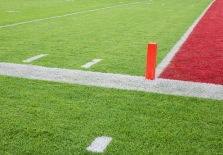While concussions result from a variety of causes (in helmeted sports, most often as a result of helmet-to-helmet contact), recent studies suggest that a small percentage (about 10 percent in football) are caused by an athlete's head hitting the playing surface.
A properly maintained playing surface can help minimize head injury risk. Whether natural or synthetic turf, field management practices directly affect field hardness and, in turn, the risk of head injury.
As a result, monitoring field hardness is key. (In fact, the NFL now requires field managers to measure surface hardness before every game.)

Measuring hardness
Surface hardness is measured by dropping a weight - often referred to as a missile - from a fixed height onto the playing surface. The missile contains an accelerometer that measures how fast the missile stops once it hits the surface. A numerical value (referred to as Gmax) is then generated.
A high Gmax value indicates the missile stopped quickly. Think of this as dropping the missile onto concrete. If the missile was dropped onto a pillow, it would take a longer time for the missile to stop and the softer surface would produce a lower Gmax value.
A value of 200 Gmax is considered to be a maximum threshold to provide an acceptable level of protection to users and has been accepted by the U.S. Consumer Product Safety Commission.
The NFL requires that playing surface hardness of both natural and synthetic turf fields be measured with a device called a Clegg Impact Tester. Fields must be tested in multiple locations prior to every game and must be below 100 Gmax.
Infill levels determine hardness
In ensuring that an artificial turf field doesn't get dangerously hard, here are some key things to keep in mind:
- Low infill levels increase hardness: Elevated surface hardness levels are almost always associated with low levels of the infill material (the crumb rubber or crumb rubber plus sand underneath the surface) that cushions on impact.
- "Walk-off" rubber reduces infill levels: Unlike the soil on natural turf fields, which can get harder from compacting, synthetic turf fields get harder because the infill material is actually being removed gradually from the field over time because it gets caught in players' cleats. While seemingly insignificant, those small amounts multiplied by all of the shoes on that field over time add up and comprises what is referred to as "walk-off" crumb rubber.
- High-use areas are most prone to increased hardness: The majority of rubber "walks off" from high-use areas of the field, where the majority of play occurs.
- Paint build-up can increase hardness, too: If the field is painted on a regular basis, paint can build up over time and result in elevated surface hardness values.
Monitoring hardness:
- Ideally, synthetic turf fields should be tested once per year.
- Hire an independent field testing agency or conduct your own testing:
- Ask your turf manufacturer for the names of testing agencies in your area; or
- Invest in a Clegg Impact Tester which cost approximately $4,000, which will allow testing on a more regular basis.
Preventing elevated surface hardness
- Measure infill levels on a regular basis using a fir-proofing depth gauge, which can be purchased for less than $20.00;
- Monitor painted areas for hardness using a Clegg Impact Tester or an independent testing agency;
- Compare to the infill depth recommendations provided by your field manufacturer;
- Add rubber when infill levels drop below the field manufacturer's range. Rubber may only be needed to a small area such as a lacrosse goal mouth if it is a multi-sport field. Or the entire field may require additional rubber. Be sure to have additional rubber on hand of the same kind as that currently in the field; and
- Scrub and remove paint occasionally (the NFL suggests that paint be scrubbed and removed after approximately every four paintings on synthetic turf fields throughout the league).
Posted April 20, 2015








